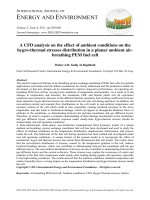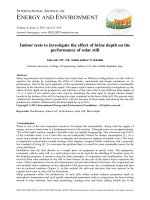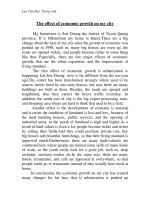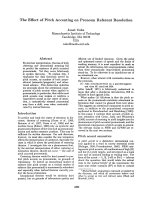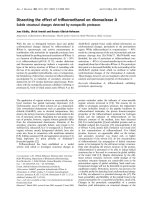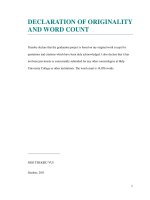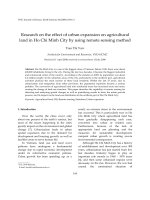THE EFFECT OF FORESHORE LOWERING ON BAC LIEU SEA DIKE
Bạn đang xem bản rút gọn của tài liệu. Xem và tải ngay bản đầy đủ của tài liệu tại đây (5.63 MB, 97 trang )
MINISTRY OF EDUCATION
AND TRAINING
MINISTRY OF AGRICULTURE AND
RURAL DEVELOPMENT
THUY LOI UNIVERSITY
__________________________________
LE THI HIEN
THE EFFECT OF FORESHORE LOWERING
ON BAC LIEU SEA DIKE
Major:
Coastal Engineering and Management
Code:
62580203
MASTER THESIS
SUPERVISER 1:
Dr. LE HAI TRUNG
SUPERVISER 2:
Assoc. Prof. Dr. TRAN THANH TUNG
HANOI - 2016
i
ACKNOWLEDGEMENTS
First of all, I would like to thank to my supervisors, Assoc. Prof. Dr. Tran Thanh Tung
and Dr. Le Hai Trung for his great contribution in this thesis. I would like to express
my deep gratitude especially to my main supervisor Dr. Le Hai Trung for being so
patient with me and for all of his supports and inspiration.
My gratitude also goes to colleagues from Southern Institute of Water Resources
Research who have supported me in my research work. I also deeply indebted to
Assoc. Prof. Dr Dinh Cong San and Dr. Nguyen Duy Khang, who have significant
contribution to my research. I also would like to thanks to M.Sc Nguyen Quang Duc
Anh and Mr.Nguyen Cong Phong for providing whole-hearted assistance to my thesis.
Finally I would like to thank my family and friends for all of the time we’ve been
through together.
Ha Noi, October 2016
Le Thi Hien
ii
DECLARATION
I hereby declare that is the research work by myself under the supervisions of Assoc.
Prof. Dr. Tran Thanh Tung and Dr. Le Hai Trung. The results and conclusions of the
thesis are fidelity, which are not copied from any sources and any forms. The reference
documents relevant sources, the thesis has cited and recorded as prescribed. The
results of my thesis have not been published by me to any courses or any awards.
Ha Noi, October 2016
Le Thi Hien
iii
TABLE OF CONTENTS
LIST OF FIGURES....................................................................................................iii
LIST OF TABLES.......................................................................................................vi
ABSTRACT..................................................................................................................1
CHAPTER 1. LITERATURE REVIEW....................................................................3
1.1.Introduction.............................................................................................................3
1.2.Foreshore and mangrove..........................................................................................4
1.3.Design of sea dike with regard to foreshore and mangrove.....................................8
1.4.Discussion.............................................................................................................. 10
CHAPTER 2. FORESHORE LOWERING AND ITS IMPACTS.........................12
2.1.Introduction...........................................................................................................12
2.2.Description of the Bac Lieu sea dike.....................................................................12
2.2.1. Topography and geomorphology.................................................................12
2.2.2. Hydrodynamic characteristics.....................................................................14
2.2.3. Foreshore and mangrove.............................................................................19
2.2.4. Bac Lieu sea dike system............................................................................23
2.3.Governing factors and classification of the foreshore lowering mechanism..........26
2.3.1. Governing factors of the foreshore lowering mechanism............................26
2.3.2. Classification of the foreshore lowering mechanism...................................31
2.4.Sea dike under impact of foreshore lowering.........................................................32
2.5.Summarise.............................................................................................................33
CHAPTER 3. MODELling of the FORESHORE LOWERING mechanism........34
3.1.Overview...............................................................................................................34
3.2.Model set – up, calibration and verification...........................................................34
3.2.1. Introduction to Mike 21..............................................................................34
3.2.2. Model set –up for a large domain................................................................36
3.2.3. Model set - up for a small domain...............................................................38
3.2.4. Model calibration and verification..............................................................40
3.3.Boundary conditions and simulation scenarios......................................................49
3.3.1. Boundary conditions...................................................................................49
3.3.2. Simulation scenarios...................................................................................49
i
3.4.Simulation results..................................................................................................50
3.4.1. Wave...........................................................................................................50
3.4.2. Current........................................................................................................52
3.5.Dicussion and conclusion......................................................................................54
CHAPTER 4. the EFECT OF FORESHORE LOWERING ON SEADIKE........57
4.1.Introduction...........................................................................................................57
4.2.Changes of the bathymetry....................................................................................57
4.3.Changes in the wave characteristics.......................................................................59
4.4.The effect of foreshore lowering on sea dike.........................................................61
4.4.1. Sea dike design without mangrove forest....................................................62
4.4.2. Sea dike design with mangrove forest in the case of a lowered foreshore...64
4.5.Discussion..............................................................................................................66
CONCLUSION..........................................................................................................69
APPENDICES............................................................................................................75
ii
LIST OF FIGURES
Fig.1-1: Energy dissipation of waves on higher floodplains with mangroves (Albers et
al., 2013)...................................................................................................................... 10
Fig.2-2: Map of the Mekong delta...............................................................................12
Fig.2-3: The location of the study sea dike..................................................................13
Fig.2-4: The average long-term wave field of Con Dao(KHCN-BĐKH/11-15, 2015) 15
Fig.2-5: The average long-term wind field of Con Dao(KHCN-BĐKH/11-15, 2015).17
Fig.2-6: Direction and speed of the winter currents(KHCN-BĐKH/11-15, 2015).......18
Fig.2-7: Direction and speed of the summer currents(KHCN-BĐKH/11-15, 2015)....18
(i)The large eroded beach (ii)Deeply eroded offshore................................................20
Fig.2-8: The erosion phenomenon at the Northern area of windmill field in Bac Lieu
( Sources: Le Hai Trung).............................................................................................20
Fig.2-9: The mangrove forest erosion at Ganh Hao town, Bac Lieu province.............22
Fig.2-10:Mangrove tree left in front of Nha Mat embankment....................................22
Fig.2-11:The current status of forest beach at a canal gate out to the sea.....................22
Fig.2-12:Preliminary locations of survey Bac Lieu sea dike in Aug- 2014..................23
Fig.2-13: The sea dike hardened of Nha Mat estuary...................................................24
Fig.2-14:Two type of protection structures applied at Nha Mat...................................25
Fig.2-15:The construction current status of concrete dike from Lang Ong Hai Nam to
Ganh Hao estuary........................................................................................................26
Fig.2-16:The current status of concrete dike defence Ganh Hao town.........................26
Fig.2-17: The sediment accumulation and the trend of sediment transport in Mekong
Delta, which is affected dominantly by northeast monsoon (Sources: Marine
economy.vn)................................................................................................................28
Fig.2-18:The section of tidal beach is surface eroded (Loi, 2015)...............................31
Fig.2-19: The section of tidal beach is background eroded (Loi, 2015).......................31
Fig.2-20: The section of tidal beach is deep eroded (Loi, 2015)..................................32
Fig.2-21: The foreshore lowering process....................................................................33
Fig.3-22:The topography data of the study area(KHCN-BĐKH/11-15, 2015)............37
Fig.3-23:The large domain gird of the calculation area (KHCN-BĐKH/11-15, 2015) 37
iii
Fig.3-24: The large domain topography of the calculation area (KHCN-BĐKH/11-15,
2015)............................................................................................................................ 38
Fig.3-25:The topography data at the study area(KHCN-BĐKH/11-15, 2015).............39
Fig.3-26:The mesh of the calculation area (KHCN-BĐKH/11-15, 2015)....................39
Fig.3-27: The topography of the detailed calculation area (KHCN-BĐKH/11-15, 2015)
..................................................................................................................................... 40
Fig.3-28:The location of the water level measuring station.........................................41
Fig.3-29:The calculation boundaries of the area..........................................................41
Fig.3-30:The calibrated result of measured water level and computed at Dinh An inlet
..................................................................................................................................... 43
Fig.3-31: The calibrated result of measured water level and computed at Tran De inlet
..................................................................................................................................... 43
Fig.3-32:The location of water level measuring stations.............................................44
Fig.3-33:The verification result of measured water level and computed at My Thanh
inlet.............................................................................................................................. 45
Fig.3-34: The verification result of measured water level and computed for Ganh Hao
inlet.............................................................................................................................. 45
Fig.3-35:Wave height (left) and wave period (right) on the Bien Dong area of Wave
Watch III model...........................................................................................................46
Fig.3-36: Wave model calibration................................................................................47
Fig.3-37:The location of wave measuring station of Nha Mat estuary.........................48
Fig.3-38: Wave model verification...............................................................................48
Fig.3-39: The distribution of the characteristic wave for the northeast monsoon (left),
the southwest monsoon (right).....................................................................................50
Fig.3-40: The location of extract points of calculation result.......................................50
Fig.3-41:The significant wave height chart for climate one year (May 2011 to April
2012) at positions P1, P2, P3.......................................................................................51
Fig.3-42: The distribution of total currents (speed and direction) when tide going up
(left), going down(right) in northeast monsoon scenario.............................................52
Fig.3-43: The distribution of total currents (speed and direction) when tide going up
(left), going down (right) in southwest monsoon scenario...........................................52
iv
Fig.3-44: The distribution of currents at the time of tide when going up (left) and going
down (right) - the scenario only considers to effect of tide..........................................53
Fig.3-45:The chart of distribution of currents speed in 1 year climate (May 2011 April 2012) at P1,P2, P3 position................................................................................53
Fig.3-46: Simulated result of the average currents distribution due to wind in northeast
monsoon season (left) and southeast monsoon (right).................................................54
Fig.4-47: The measured topography of March 2011 (left) and January 2015 (right)
(KHCN-BĐKH/11-15, 2015).......................................................................................57
Fig.4-48: The calculation topography of March 2011 (left) and January 2015 (right)
(KHCN-BĐKH/11-15, 2015).......................................................................................58
Fig.4-49: The foreshore lowering in 2015 compared to 2011......................................58
Fig.4-50:The location of cross sections.......................................................................59
Fig.4-51: Wave propagation and evolution of cross section 1 in 2011 and 2015.........60
Fig.4-52: Wave propagation and evolution ofcross section 2 in 2011 and 2015..........60
Fig.4-53: Wave propagation and evolution of cross section 3 in 2011 and 2015.........61
Fig.4-54: The effect of the foreshore lowering on sea dike..........................................68
v
LIST OF TABLES
Table 1-1: The area of mangrove forest in Mekong Delta (Loi, 2015)......................4
Table 1-2:The area of mangrove forest in Mekong Delta from 1973 to 2012..........5
Table 3-3: The parameters of the tidal model..........................................................42
Table 3-4: The coordinates of measuring stations...................................................44
Table 3-5: The parameters of the wave model.........................................................46
Table 3-6: Simulation scenarios................................................................................49
Table 4-7:The input parameters used for Wadibe...................................................62
Table 4-8: The parameters of mangrove forest........................................................62
Table 4-9: Design parameters of cross section 2, without mangrove......................64
Table 4-10: Design parameters of cross section 2 with topography in 2015 (with
mangrove)................................................................................................................... 65
vi
ABSTRACT
1. Rationale
In recent years, the erosion of beaches and estuaries in Bac Lieu has gradually
intensified. Especially, foreshore lowering phenomenon has been happening at area
adjacent Soc Trang province. This has severely affected the safety of local inhabitants,
the quality of infrastructure, the degradation of environment, and the economic
development. This is the critical reason that the author do the research "The effect of
foreshore lowering on Bac Lieu sea dike".
2. Study objectives
The aim of study is to find out the effect of mangrove foreshore lowering to Bac Lieu
province. In order to achieve the purpose of research that should deal with the bellow
problems:
- Literature review
- Foreshore lowering and its impacts
- Numerical modelling of the foreshore lowering
- The effect of foreshore lowering on sea dike
Simulation of the hydrodynamic regime, the erosion and accretion mechanism of the
area. Evaluating the influences, effects of the foreshore lowering on sea dike. The
study is applied to calculate specifically for 1 km of sea dike in Vinh Trach Dong
commune, Bac Lieu city, Bac Lieu province.
3. Study approaches and methodology
Evaluation for the effect of foreshore lowering on Bac Lieu sea dike by using Mike21
model for hydrodynamic regime simulation and then design a typical cross section.
Methodology is shown in lower figure.
1
Firstly, basing on previous studies and analysis, available informations use to define
current status of foreshore, mangrove forest and sea dike system; governing factors of
the foreshore lowering mechanism.
Secondly, collection of data: These data are used as input for calibration and
verification of models. These are included: topography, wave and water level data
Thirdly, set up model: It includes computation network, meshes, defined boundaries.
The study is using two computation domain including large domain and small domain.
Large domain used calibration and verification model, small domain used
hydrodynamic simulation.
Fourthly, The scenarios proposed for study are based on the impact factors foreshore
lowering. The next is simulation of hydrodynamic regime of study area. Given change
of the wave and current when the foreshore is lowered and then calculation, design for
a typical dike cross section.
Lastly, in this content, author will summary the results conducted in the study.
2
CHAPTER 1. LITERATURE REVIEW
1.1. Introduction
For the last few years coastal erosion has become more severe in Cuu Long Delta in
general and in Bac Lieu province in detail. Bac Lieu, one of 28 coastal provinces of
Vietnam, whose total coastline is 56 km accounting for 1.27% of the coastline of the
country. Coastal and estuarine erosion in Bac Lieu has been more frequent and its
intensity has been increasingly severe through time. Noticeably, the mangrove forest
belt has been gradually eroding and losing. In three years, from 2011 to 2014, the 11
km sea dike from Vinh Trach Dong commune bordering Soc Trang to Nha Mat Canal
totally lost 119 meters.
This area was affected by the convergence of waves and the semi- diurnal tide of Bien
Dong regime. Under the effect of waves, wind, etc…, this area with its weak
geological features is easy to get eroded and lose its coastline stability. The mangrove
forest area in front of sea dike has been narrowing at an alarming rate. Losing this area
of forest has put a high pressure on the stability of the sea dike system in the area of
Soc Trang and Bac Lieu. Unless there is an urgent and effective measure taken to
protect and restore the mangrove forest, many parts of this sea dike will be at risk of
erosion, instability or breaches.
Obviously, erosion and coastline fluctuation in Bac Lieu province is an enormous
obstacle
holding
back
the
social
economic
development,
industrialization,
modernization, especially in the process of accelerating marine economy. This
research is going to study and analyze in order to evaluate the situation as well as to
find out the causes of erosion in the area of sea dike in Bac Lieu province. It will be an
important foundation to propose plans, construction, upgradation and effective
protection for the sea dikes to cope with the effects of climate change and sea level rise
in the future.
3
1.2. Foreshore and mangrove
The mangrove forest plays an enormous role in preventing coastal erosion and
mitigating natural disaster. However, at present the area of the forest was rapidly
decreased due to many causes such as erosion. Moreover, the trees are old and their
ability to reproduce and grow is limited, which means the forest is easily affected by
natural factors like weather, wave, wind and tide.
The width of the forest belt in some areas was significantly reduced, which leads to the
inability to support the sea dike, no regeneration tree belt develops toward the sea.
There have been some domestic studies conducted on the erosion situation and its
causes and the reduction of mangrove forest in Mekong Delta. By the end of 2014,
seven provinces in Mekong Delta have totally 91.168 hectare of mangrove forest (Loi,
2015), the majority of which is protective forest as shown in the Table 1 -1.
Table 1-1: The area of mangrove forest in Mekong Delta (Loi, 2015)
Specialized forest
Total
Province
Protective forest
Productive forest
(hectare)
(hectare)
Natural
Planted
Natural
Planted
Natural
Planted
forest
forest
forest
forest
forest
forest
Tien Giang
1.512
0
0
0
1.512
0
0
Ben Tre
4.147
848
1.022
408
1.433
16
420
Tra Vinh
7.474
0
0
1.599
5.875
0
0
Soc Trang
5.159
0
0
1.332
3.827
0
0
Bac Lieu
2.806
0
0
1.328
1.478
0
0
Ca Mau
65.288
4.431
4600
1.774
24.868
0
29.797
Kien Giang
4.782
0
0
805
3.977
0
0
Total
91.168
5.279
5.622
7.246
42.97
16
30.217
Loi (2015) performed satellite image interpretation and overlaid satellite image
Landsat for Mekong Delta area over the period from 1973, 1989, 2001 and 2012. She
4
used software to extract fluctuation forest area and it was shown that the mangrove
forest area has reduced by 100.000 hectares for the last 40 years.
Table 1-2:The area of mangrove forest in Mekong Delta from 1973 to 2012
Year
Area (hectare)
1973
163.343,37
1989
90.714,62
2001
58.980,6
2012
50.429,86
In the study, the author also made a comment that the coastal mangrove forest erosion
phenomenon has a growing trend in recent years. Before 2000s, the erosion
phenomenon only occured in some certain regions where erosion and accretion
phenomenon are intertwined. Since 2000, erosion phenomenon is sharply increasing in
both area and intensity. Erosion hardly occured in coastal regions of Bac Lieu and
Soc Trang in the past, but this has happened in tens of kilometers since 2000s up to
now.
Mangrove forest erosion previously occurred only in coastal regions of the Bien Dong
and accretion appeared in the Bien Tay in Ca Mau, now the mangrove forest erosion in
the Bien Tay area is also happening at a very high rate, up to 40 m/ year in some
regions. The author also pointed out some causes of reducing the mangroves forest.
First, many parts of the forest have been used for agriculture land or aquaculture.
Deforestation, overexploitation of mangroves forest, coastal fishing activities,
construction, and natural factors are also listed as the causes.
Recently, there has been research about the effect of coastal foreshore lowering on
wave height growth in Bac Lieu province, Vietnam. The surveyed bathymetric data
and wave climate and water level data at site were used for numerical modelling with
the Mike21 software suite. The study on foreshore lowering along Bac Lieu coastline
with surveyed data in 2011 and 2015 showed that the local beach is eroded and this
allows waves to propagate further landward, at the same time raises the wave height.
Results showed that with an offshore design wave of 5.59 m, when the foreshore
lowers by 1.3 m, the nearshore wave will grow by 0.49 m at most. Therefore, in
studying coastal erosion processes, it is necessary to consider the lowering of
foreshore and beaches, the causes of erosion by wave growth (Tung et al., 2015).
5
In the research "Shoreline change of the Mekong River delta along the southern part of
the Bien Dong coast using satellite image analysis (1973-2014)", Besset et al.(2015)
used Landsat satellite images in order to track recent deltaic shoreline changes along
the Bien Dong coast south of the mouths of the Mekong. Besides, the technique was
used for determining changes in mangrove cover liable to be an exacerbating factor in
shoreline erosion and determining of shoreline change rates (m/year) between 1973
and 2014. The analysis showed that nearly 70% of the 160km - long shoreline of the
delta has been strongly eroded. The coastal surface losses attained 4.40 km²/year over
the period 1973-2014, and even more between 2003 and 2011 with a loss of 6.98
km²/yr. Land-use changed and vegetation lost between 2003 and 2011, mainly
consisting of seafront fringe mangroves, along a sector of the eroding coast in Bac
Lieu Province. An area of 60 ha of vegetation were lost during the period 2003-2011.
In these sectors of eroding coast, mangroves have been replaced by aquaculture,
particularly shrimp farming.
Linking rapid erosion of the Mekong River delta to human activities using highresolution satellite images showed that the Mekong delta is now dominated by rampant
erosion. The rate of land loss is nearly 2.3 km 2 /year in 2003–2012 along the Bien
Dong coast, the shoreline retreat over this period having affected over 50% of the large
600km long coast, and even up to 90% of the muddy Bien Dong coast. Decreasing
river sediment supply to the coast is deemed to be the prime cause of this erosion, and
most likely due to existing dam retention of sediment and to massive channel-bed sand
mining in the delta (Anthony et al., 2015).
Monitoring the shoreline change in coastal area of Ca Mau and Bac Lieu province
from 1995 to 2010 had been conducted using remote sensing and GIS. It was shown
that coastal erosion and accretion in Ca Mau and Bac Lieu in this period was very
complex. Erosion and accretion process were periodly intertwined. According to
fieldwork result, Nha Mat area of Bac Lieu province was rapidly eroded in the period
of 2000-2005, and from 2005 to 2010 the trend was going down, with 0.5 to 5 meters
per year, due to the construction of a breakwater (Diem et al., 2013).
6
The research of shoreline change in Southern Vietnam from Ho Chi Minh to Kien
Giang by Hung et al. (2012) used the technique of overlaying maps and analyzing
satellite images to describe a full view of coastal erosion and accretion in areas from
Ho Chi Minh City to Kien Giang province. The authors divided the researched area
into 9 small areas and analyzed the shoreline erosion process. The research results
showed that the western coastal area was quite stable and accretion process was
dominant. In the eastern sea area, the process of erosion and accretion was mutually
interleaved. The article also drilled down the main factors affecting erosion and
accretion process including natural factors and human activities, which served as the
base for solutions to prevent this situation and preserve the area.
In the research "Modeling transport and deposition of the Mekong River sediment" the
authors applied a coupled wave–ocean–sediment transport model to simulate the
Mekong shelf circulation the transport and dispersal of Mekong - derived fine
sediments in 2005. In summer, a large amount of fluvial sediment was delivered and
deposited near the Mekong river mouth. In the following winter, strong ocean mixing
and coastal current lead to resuspension and south-westward dispersal of a small
fraction of previously deposited sediments. Strong wave mixing and downwelling
coastal current associated with the more energetic northeast monsoon in the winter
season are the main factors controlling the southwestward along-shelf transport (Xue Z
et al., 2012).
The research “Building mangrove protection forest in coastal zone, reality and
solution” indicated that although the mangrove forest belt in this area grew in a good
way since 20 years ago on clayey sand, and extending up to 500m seaward (the trees
are matured with trunk diameters of 20÷30 cm), there have been visible forest
degradation. The erosion occurs first in narrow trenches, 20÷ 30 m wide perpendicular
to the shoreline. The trenches then gradually expands, causing land loss on both sides.
The eroded phenomenon in mangrove forest still occur in some segments of sea dike
of Soc Trang, Bac Lieu provinces (Que, 2012).
Aresearch about the tendency of sediment transport in coastal Mekong delta showed
that sediment transport process has heavily influenced by longshore current regime
7
due to influence of wind, tide and wave activity in close to coastal area. That sediment
is transported to southwest, when passing Ca Mau cape, sediment current travel toward
the northwest along the west coast of Ca Mau peninsula. Where the most sediment
accumulation is a wet delta around Ca Mau peninsula (from Bo De inlet to Cua Lon
area), and potential erosion zone is Soc Trang- Bac Lieu coastal area, especially the
sea level rise (Thanh et al., 2011).
1.3. Design of sea dike with regard to foreshore and mangrove
In the Mekong Delta, sea dikes function to prevent salinity intrusion and flooding, it
often works directly under the effect of waves and flows. Boundary conditions for
design are hydrodynamic characteristics such as water level, wave, flow regime.
Besides, several loads such as means of transport on the dike must not be ignored in
calculation. According to several studies, foreshore element and mangrove forest
should be taken into consideration in design process.
The foreshore is a buffer zone, where reciprocating movement of sediment takes place
from high beach down to low beach or vice versa, which depends on features of
seasonal wave. The foreshore plays the role of reducing wave impact on high beach
and constructions and infrastructure built along the shoreline. In the summer, under the
impact of small wave, sediment moves from low beach up to high beach and the
reversal happens in the winter under the effect of swell. If the foreshore is a wide
mudflat area, a gentle slope, with the growth of mangrove, used as an aquaculture area,
both show is protect for land region inside beach under effect of wave and flow
current.
The research about the safety, stability of the foreshore has direct effect on safety and
stability of coastal in general and sea dike construction, coast protection construction
in particular. The effect of foreshore on the safety and stability of sea dike is
understood as effect and impact caused by its narrowing and lowering process. The
foreshore is often affected by hydrodynamic elements such as wave, storm surge, tide
and longshore currents. The effect of foreshore on the safety and stability of dike is
reviewed by two main factors including narrowing the width of the dike due to erosion
and lowering the height of the dike compared with the original surface elevation.
8
Besides, the foreshore is extremely important for safety of dike, especially for high
energy beach areas. Therefore, to stabilize the sea dike, foreshore protection is more
important, needs more attention and investment (Tien, 2015).
A recent research by Trung (2015) showed that in the Mekong Delta, sloping earthen
dike has been built for tens of years and seems to be consistent with material condition
and foundation of the region. Preliminarily, surveys have found out that rubble –
mound structure, gabion is suitable for sea roof, grow grass embankment can be
applied for field roof. The common condition in front of the dike is existence of a strip
of mangrove forest, which makes lower the power of the waves hitting to the foot of
the dike, so it is not necessary to use complex structures and burdensome. Moreover,
the foundation here is quite weak, which is not suitable for large dike sections and
heavy structures.
According to the research and the proposed forms of the sea dike section (part 2) the
foreshore has effects on sea dike design. The foreshore has a special influence on the
amount of wave overtopping through dike and therefore, on the safety of construction.
The research showed that in the same design loading condition when depth of
foreshore increases, the amount of wave overtopping over dike will increase according
to exponential law, and to maintain the level of safety, the crest elevation of dike must
also be raised equivalent to the increase of freeboard by 1 to 3 times with one of depth
foreshore. So, in sea dike design, it is necessary to consider the foreshore inseparable
to ensure the safety and long term stability of construction. Forecasting and monitoring
changes in foreshore morphology need to be regularly carried out as a part of
maintaining the sea dike construction (Cat, 2012).
Besides, the mangrove forest is also an important factor to be taken into consideration
throughout the design process. The Decision 667/QD-TTG released by the Prime
Minister on approving consolidation program, upgrading sea dike system from Quang
Ngai to Kien Giang claimed that new sea dikes must be built on a principle of having
mangrove forest stretch at least 500 meters wide.
On coasts with low-lying floodplains, consisting either of marsh or a mangrove belt,
the floodplain is an important stabilizing element of the coastal protection system. It
9
protects against coastal erosion and flooding. The higher the floodplain, the greater the
wave dissipation on it, and as a result, the wave load on the dike is decreased
significantly. In the presence of mangroves, the wave reduction effect is even larger
(Fig. 1 -1). Mangroves also reduce storm surge water levels by slowing the flow of
water and reducing surface waves (Albers et al., 2013).
Fig.1-1: Energy dissipation of waves on higher floodplains with mangroves
(Albers et al., 2013)
1.4. Discussion
Most researches have focused on assessing the degradation of mangrove forest,
erosion and retreat of the Mekong Delta coastline, and particularly Bac Lieu area.
Basing on the analysis of satellite image, we can consider the coastline evolution
process, degradation of mangrove forest area over the years. A research in 2015 using
numerical modelling to assess the foreshore lowering of Bac Lieu area. The
phenomena of coastal erosion, strong degradation of protective mangrove forests have
pushed sea dike to the brink of danger and threatened human life. For that reason,
giving causes, trend of coastal erosion and propose timely solutions are imperative.
Generally, coastal erosion and mangrove forest attenuation in Mekong Delta,
specifically in Bac Lieu are a problem particularly in need of attention and opportune
solutions. The coastal erosion and loss of mangrove forest will cause damage to the
foundation of a sea dike system. So, designing sea dikes must take foreshore and
mangrove forest into consideration. In the scope of this thesis, the author primarily
10
focus on the current status of foreshore lowering, trend of sediment transport of the
study area and the impact of foreshore lowering on the behind sea dike system. To
clarify the issue of the study, the author choose numerical modelling to simulate the
circulation and wave field for the study area.
11
CHAPTER 2. FORESHORE LOWERING AND ITS IMPACTS
2.1. Introduction
The foreshore lowering phenomenon would be caused by many factors and its impact
on mangrove forest and sea dike system is considerable. Soc Trang, Bac Lieu coastal
areas are affected of wave, longshore currents, which are at risk of coastal erosion,
especially in the trend of sea level rise. Multiple shoreline segments areas seriously
eroded and foreshore surface is being gradually lowered vertically, which causes
mangrove forest to die as their roots are pulled up. As a result, mangrove forest area
was reduced and alarmingly degraded. And sea dike is affected in return.
2.2. Description of the Bac Lieu sea dike
2.2.1. Topography and geomorphology
As a part of Ca Mau peninsula, Bac Lieu is a coastal province in the Mekong Delta,
see Fig. 2 -2. Bac Lieu borders Can Tho, Kien Giang to the north-west, SocTrang to
the north-east, Ca Mau to the south-west, and Bien Dong to the south - east. The
province has a coastline of 56 km long connecting three large estuaries: Ganh Hao, Cai
Cung and Nha Mat. The natural land area is 2.521km2.
Fig.2-2: Map of the Mekong delta
12
Bac Lieu consists of 5 districts: Vinh Loi, Hong Dan, Gia Rai, Phuoc Long, Dong Hai
and Bac Lieu town. Bac Lieu has relatively even and flat terrain, most of which is
1.2m higher than the sea level. Bac Lieu has sand dunes from 1.0 m to 3.0 m high,
running parallel along the shoreline. Mudflats appear along the coastline, most of
which are temporarily submerged at high. Outside of the mudflats is shallow sea area.
Strips of mangrove forest along the coastline serve as protective shields against
harmful effect from wave, wind and sea level. The terrain, which is tendentiously steep
from the coastline towards the inland, from north-east to south-east, is separated by a
network of rivers and canals. There are many large canals such as Quan Lo, Phung
Hiep, Canh Den, Pho Sinh and Gia Rai. The topography and geomorphology along the
shoreline are heterogeneous among its areas, which is the result of the interaction
between the natural elements such as geological structure and tectonics, the process of
marine activities, the impact of the river, the role of mangrove forest and human
activities modifying the land surface. The typical beach segment involved in the
survey belongs to the dike section from K0 to K1+200, starting from the border of
Soc Trang – Bac Lieu extending north towards Nha Mat inlet, with a total length of 1
km. It borders the Bac Lieu wind power project area to the north and the protective
mangrove forest to the South. The surveyed sea dike located in Vinh Trach Dong
commune, Bac Lieu city, Bac Lieu province.
Fig.2-3: The location of the study sea dike
13
2.2.2. Hydrodynamic characteristics
The tidal regime
Bac Lieu has the Bien Dong tidal characteristics, consisting of two different regions in
the east and in the west. Namely, the East bank takes the unevenly semi-diurnal
characteristics. Every day, the sea level goes up and down twice with 3 m to 4 m of
tide amplitude, ranked the highest in the country. The average water level is 1.7 m and
the maximum water level difference two tide periods is from 1.5 m to 2 m while the
minimum one is from 0.5 m to 0.6 m. In contrast, the west bank has the mixed tidal
regime inclined irregular tide, with small tidal amplitude.
Wave conditions
The wave in Bac Lieu is similar to coastal wave in eastern Mekong Delta. It is
typically the mixing wave under the direct influence of local wind. The elevation and
year cycle are 1.6 m and 5.5 seconds respectively. Besides, the maximum elevation
and maximum cycle observed can be up to 10.5 m and 11.5 seconds.
During the northeast monsoon, waves whose frequency is less than 1m high account
for 82%, in which the north-east ward and the northward ones accounts respectively
for 49% and 24%. The waves whose height is from 1 to 1.5m account for 12%. Swells
with height between 1.9 m and 3.7 m high, comprise 20%, in which the northward one
accounts for 19%. Higher swells 3.7 m accounts for 7%, the frequency was 65% calm.
On the southwest monsoon, waves whose frequency is less than 1m accounts for 77%,
in which the south-west ward and the southward ones accounts respectively for 50%
and 15%. Waves whose height is from 1 to 1.5m account for 14%. The swell which is
from 0.3 to 1.8 m high accounts for 17%, in which the southward accounts for 9% and
southwest ward comprises 7%. The swell with height from 1.9 to 3.7 m with frequency
15% in which the southwest account for 8%, the south 7%. The swell with more than
3.7 m high account for 9%. The frequency calm wave is 69%.
14
January
February
March
April
May
June
July
August
September
October
November
December
Fig.2-4: The average long-term wave field of Con Dao(KHCN-BĐKH/11-15, 2015)
The wind regime
The studied area is located in the equatorial tropics. A year comprises two distinct
seasons: rainy season and dry season. The rainy season mainly experiences the
southwest monsoon whereas the dry season is dominantly influenced by northeast
monsoon, with and average speed of 1.77 m/s.
15
The northeast wind, called counter-wind by local people, usually comes from the east,
sometime from northeast or southeast. This type of wind appears from November to
April the following year. The frequency and speed gradually increase during this
period, reaching the maximum in February or March and then gradually reduce to
terminate in April. The wind speed is around 2 m/s to 3 m/s, inparallel direction with
large rivers.
Coastal districts are severely affected by counter-wind as the wind speed can be up to
14 m/s to 16 m/s. Combining with high tides,the strong wind may break the sea dike
system and coastal aquaculture constructions. Besides, the counter-wind and high tides
also cause surges. As a result, sea water invades the land, which affects daily life
agricultural production.
The southwest wind appears from May to October, the south - southwest winds is
coming early or late, that is important contribution to which decide whether rainy
season comes early or late.
January
February
March
April
May
June
16
